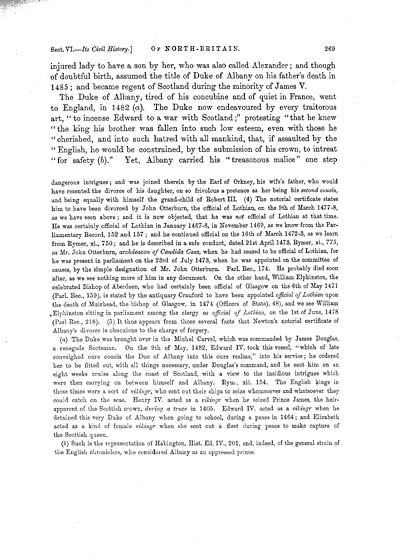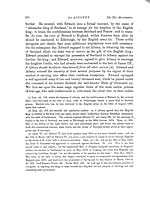Volume 3
(281) Page 269
Download files
Individual page:
Thumbnail gallery: Grid view | List view

269 injured lady to have a son by her, who was also called Alexander; and though of doubtful birth, assumed the title of Duke of Albany on his father's death in 1485 ; and became regent of Scotland during the minority of James V. The Duke of Albany, tired of his concubine and of quiet in France, went to England, in 1482 (a). The Duke now endeavoured by every traitorous art, " to incense Edward to a war with Scotland;" protesting "that he knew "the king his brother was fallen into such low esteem, even with those he " cherished, and into such hatred with all mankind, that, if assaulted by the " English, he would be constrained, by the submission of his crown, to intreat "for safety (b)." Yet, Albany carried his "treasonous malice" one step dangerous intrigues; and was joined therein by the Earl of Orkney, his wife's father, who would have resented the divorce of his daughter, on so frivolous a pretence as her being his second cousin, and being equally with himself the grand-child of Robert III. (4) The notorial certificate states him to have been divorced by John Otterburn, the official of Lothian, on the 9th of March 1477-8, as we have seen above ; and it is now objected, that he was not official of Lothian at that time. He was certainly official of Lothian in January 1467-8, in November 1469, as we know from the Par- liamentary Record, 152 and 157 ; and he continued official on the 16th of March 1472-3, as we learn from Rymer, xi., 750; and he is described in a safe conduct, dated 21st April 1473, Rymer, xi., 775, as Mr. John Otterburn, archdeacon of Candida Casa, when he had ceased to be official of Lothian, for he was present in parliament on the 23rd of July 1473, when he was appointed on the committee of causes, by the simple designation of Mr. John Otterburn. Parl. Rec., 174. He probably died soon after, as we see nothing more of him in any document. On the other hand, William Elphinston, the celebrated Bishop of Aberdeen, who had certainly been official of Glasgow on the 6th of May 1471 (Parl. Rec., 159), is stated by the antiquary Crauford to have been appointed official of Lothian upon the death of Muirhead, the bishop of Glasgow, in 1474 (Officers of State), 48), and we see William Elphinston sitting in parliament among the clergy as official of Lothian, on the 1st of June, 1478 (Parl Rec., 218). (5) It thus appears from those several facts that Newton's notorial certificate of Albany's divorce is obnoxious to the charge of forgery. (a) The Duke was brought over in the Michel Carvel, which was commanded by James Douglas, a renegade Scotsman. On the 9th of May, 1482, Edward IV. took this vessel, "which of late conveighed oure cousin the Duc of Albany into this oure realme," into his service; he ordered her to be fitted out, with all things necessary, under Douglas's command, and he sent him on an eight weeks cruise along the coast of Scotland, with a view to the insidious intrigues which were then carrying on between himself and Albany. Rym., xii. 154. The English kings in those times were a sort of vikingr, who sent out their ships to seize whomsoever and whatsoever they could catch on the seas. Henry IV. acted as a vikingr when he seized Prince James, the heir- apparent of the Scottish crown, during a truce in 1405. Edward IV. acted as a vikingr when he detained this very Duke of Albany when going to school, during a peace in 1464; and Elizabeth acted as a kind of female vikingr when she sent out a fleet during peace to make capture of the Scottish queen. (b) Such is the representation of Habington, Hist. Ed. IV., 201, and, indeed, of the general strain of the English chroniclers, who considered Albany as an oppressed prince.
Set display mode to:
![]() Universal Viewer |
Universal Viewer | ![]() Mirador |
Large image | Transcription
Mirador |
Large image | Transcription
Images and transcriptions on this page, including medium image downloads, may be used under the Creative Commons Attribution 4.0 International Licence unless otherwise stated. ![]()
| Caledonia, or, An account, historical and topographic of North Britain from the most ancient to the present times > Volume 3 > (281) Page 269 |
|---|
| Permanent URL | https://digital.nls.uk/74528636 |
|---|---|
| Description | Vol. III. |
|---|---|
| Attribution and copyright: |
|

